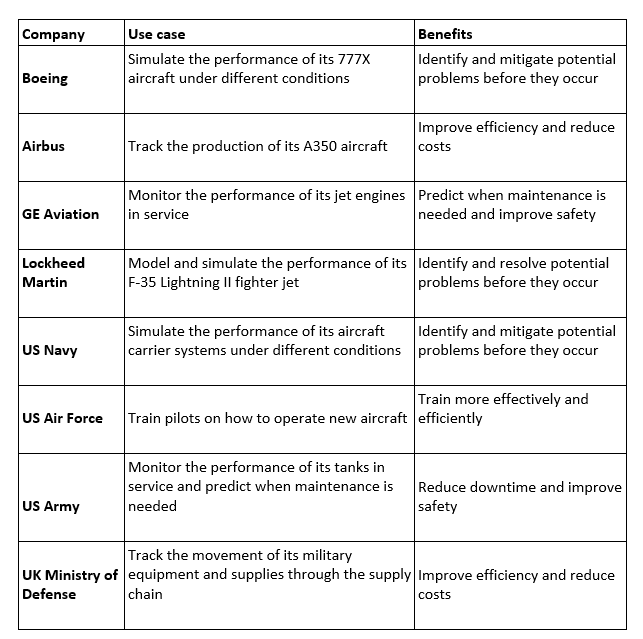Unlocking the Potential of Digital Twins in Aerospace and Defense
A digital twin is a virtual representation of a physical object or system across its lifecycle, using real-time data to enable understanding, learning, and reasoning. It is a dynamic digital representation of an industrial asset that enables companies to understand better and predict the performance of their machines, find new revenue streams, and change how their business operates.
Getting Started with Digital Twins: How They Work?
Digital Twins work by using data from sensors, IoT devices, and other sources to create a real-time representation of the physical counterpart. This digital representation allows for monitoring, analysis, and simulation, enabling better understanding and optimization of the real-world object or system.
- Data collection: Sensors and Internet of Things (IoT) devices are deployed in the physical object or system to collect real-time data.
- Data transmission: Sensors collect and transmit the data to a centralized database or cloud platform for storage and analysis.
- Data processing and analytics: Various algorithms and machine learning techniques process and analyze the collected data.
- Creating the digital twin: A digital twin model is created based on the collected and analyzed data. This model replicates a physical object or system in a virtual environment.
- Visualization and interaction: Users can interact with the digital twin through specialized software interfaces. These interfaces provide a visual representation of the object or system and its real-time status.
- Simulation and predictive analysis: Digital twins can simulate the behavior of the physical object or system under different conditions and scenarios.
- Continuous data feedback: Data from the physical object or system continues to be collected and updated in real-time to reflect any changes or deviations from the expected behavior.
- Lifecycle management: Throughout the lifecycle of the physical object or system, the digital twin can be updated and improved with new data and insights.
Virtualizing Aerospace: How Digital Twins are Revolutionizing Aircraft Design and Development
In the aerospace domain, digital twins enable rapid prototyping and testing—reducing development timelines and enhancing product reliability. Aircraft manufacturers can simulate flight conditions, assess design modifications, and optimize maintenance schedules to maximize asset availability and minimize downtime. Moreover, digital twins facilitate predictive maintenance, allowing for condition-based servicing and reducing overall maintenance costs.

Aerospace: Boeing embraces digital twins to virtualize the design and development of aircraft
Boeing has used the digital twin model to:
- Simulate the effects of different weather conditions on the 787 Dreamliner aircraft’s performance.#1
- Track the production of the 777X aircraft and help identify and resolve potential bottlenecks in the production process.#2
- Monitor the performance of 737 MAX aircraft in service to identify potential problems with the aircraft’s software and hardware.#3
- Track the movement of parts and materials through the supply chain and identify potential disruptions.
Enhancing Defense Strategies: The Role of Digital Twins in Mission Planning and Training
In the defense sector, digital twins play a pivotal role in enhancing mission planning and training. Military assets can be virtually deployed in realistic scenarios, offering valuable insights into battlefield performance and facilitating informed decision-making. Simulations help defense personnel assess risks and evaluate potential outcomes, improving preparedness and operational efficiency.
Here are some specific examples of how Lockheed Martin is using digital twins to:
- Simulate the effects of different weather conditions on the F-35 Lightning II fighter jet’s performance.#4
- Model and simulate the missile defense system for the United States.
- Track the production of the F-22 Raptor fighter jet and identify and resolve potential bottlenecks in the production process.
- Monitor the performance of the Space Shuttle in service.
- Develop a model for the supply chain and its customer support operations to track the movement of parts and materials through its supply chain and to identify potential disruptions.
Creating a Digital Twin: A 6-Step Guide to Success
- Define your goals: What do you want to achieve with your digital twin? Once you know your goals, you can start to identify the data and models you will need.
- Gather data: As digital twins are powered by data, you will need to collect data from a variety of sources, including sensors, IoT devices, and existing databases.
- Create a digital model: This model will be a virtual representation of your physical assets or process. You can use CAD software, 3D scanning, or other tools to create the model.
- Add physics and behavior: This is where you will define the rules and algorithms that govern the behavior of your digital twin. It will allow you to simulate the behavior of your physical asset or process under different conditions.
- Connect to real-time data: Once you have created your digital model, you need to connect it to real-time data from your physical asset or process to monitor the performance of your digital twin.
- Test and iterate: Once your digital twin is connected to real-time data, you need to test it thoroughly and make adjustments as needed.
Empowering Digital Twins Creation: Top Tools and Platforms
There are a number of different tools and platforms available to help you create digital twins. Some popular options include:
- AWS IoT TwinMaker
- Siemens MindSphere
- Dassault Systèmes 3DEXPERIENCE
- PTC ThingWorx
- Unity
Creating a digital twin can be a complex undertaking, but it can also be very rewarding. Digital twins can be used to improve efficiency, reduce costs, and make better decisions.
Aerospace and Defense Industries Embrace Digital Twins: Use Cases and Benefits
Market Outlook: Investment in Digital Twin Technology Set to Soar in Aerospace and Defense
- 73% of aerospace and defense organizations have a long-term roadmap for digital twin technology.#5
- Investment in digital twin technology in the aerospace and defense industries is projected to increase by 40% in 2023.#6
- Digital twins can help aerospace and defense companies save up to 15% on costs and improve their product development process by up to 25%.
The Road Ahead: Adopting Digital Twins for enhanced efficiency and innovation
In conclusion, the adoption of digital twin technology in the aerospace and defense industry represents a significant leap forward in enhancing efficiency, readiness, and innovation within these sectors.
Some of the key benefits of using digital twins in the aerospace and defense industries include:
- Improved product design and development
- Reduced costs
- Improved safety
Aerospace and defense industries will continue to see innovative and ground-breaking applications as digital twin technology matures. As a result, digital twins may revolutionize how these industries design, develop, test, and deploy new products.
References
#1 787 Dreamliner aircraft, David Slotnick, businessinsider, Sep 08, 2020: https://www.businessinsider.in/thelife/news/boeings-dealing-with-fresh-787-dreamliner-production-problems-just-as-it-prepares-to-bring-the-737-max-back-into-service/articleshow/78004281.cms
#2 777X aircraft, Stephen Trimble, flightglobal, Jun 20, 2017:
#3 737 MAX aircraft, David Slotnick, businessinsider, Sep 08, 2020: https://www.businessinsider.in/thelife/news/boeings-dealing-with-fresh-787-dreamliner-production-problems-just-as-it-prepares-to-bring-the-737-max-back-into-service/articleshow/78004281.cms
#4 F-35 Lightning II fighter jet, Courtney E. Howard, militaryaerospace, Jan 30, 2014: https://www.militaryaerospace.com/commercial-aerospace/article/14228111/f35-lightning-ii-undergoes-extensive-allweather-climatic-testing
#5 73% of aerospace and defense organizations have a long-term roadmap for digital twin, Liam Turner, buildindigital, Jun 09, 2023:
https://buildindigital.com/aerospace-and-defense-sectors-invest-heavily-in-digital-twin-tech/
#6 Investment in digital twin technology in the aerospace and defense industries is projected to increase by 40%, Liam Turner, buildindigital, Jun 09, 2023:
https://buildindigital.com/aerospace-and-defense-sectors-invest-heavily-in-digital-twin-tech/
Latest Blogs
Core banking platforms like Temenos Transact, FIS® Systematics, Fiserv DNA, Thought Machine,…
We are at a turning point for healthcare. The complexity of healthcare systems, strict regulations,…
Clinical trials evaluate the efficacy and safety of a new drug before it comes into the market.…
Introduction In the upstream oil and gas industry, drilling each well is a high-cost, high-risk…





